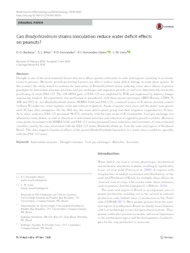Can Bradyrhizobium strains inoculation reduce water deficit effects on peanuts?
Can Bradyrhizobium strains inoculation reduce water deficit effects on peanuts?
Author(s): BARBOSA, D. D.; BRITO, S. L.; FERNANDES, P. D.; FERNANDES JUNIOR, P. I.; LIMA, L. M. de
Summary: Drought is one of the environmental factors that most affects peanut cultivation in semi-arid regions, resulting in economic losses to growers. However, growth promoting bacteria are able to reduce water deficit damage in some plant species. In this context, this study aimed to evaluate the interaction of Bradyrhizobium strains reducing water stress effects on peanut genotypes by antioxidant enzymes activities, leaf gas exchanges and vegetative growth, as well as to determine the taxonomic positioning of strain ESA 123. The 16S rRNA gene of ESA 123 was amplified by PCR and sequenced by dideoxy Sanger sequencing method. An experiment was performed in greenhouse with three peanut genotypes (BRS Havana, CNPA 76 AM and 2012-4), two Bradyrhizobium strains (SEMIA 6144 and ESA 123), a mineral source of N and an absolute control (without N) under two water regimes (with and without irrigation). Seeds of peanut were sown and the plants were grown until 30 days after emergence. On the 20th day, the water deficit plants group had their irrigation suspended for 10 days. At in silico analyzes, ESA 123 presented 98.97% similarity with the type strain of B. kavangense. Leaf gas exchange was affected by water deficit; as well as alteration of antioxidant activities and reduction of vegetative growth variables. However, some plants inoculated with SEMIA 6144 and ESA 123 strains presented lower reductions and increment of some evaluated variables, mainly the ones inoculated with the ESA 123 strain, Bradyrhizobium sp. from the semi-arid region of Northeast Brazil. This data suggests beneficial effects of the peanut-Bradyrhizobium interaction in a water stress condition, specially with the ESA 123 strain.
Publication year: 2018
Types of publication: Journal article
Unit: Embrapa Semi-arid Region
Observation
Some of Embrapa's publications are published as ePub files. To read them, use or download one of the following free software options to your computer or mobile device. Android: Google Play Books; IOS: iBooks; Windows and Linux: Calibre.
Access other publications
Access the Agricultural Research Database (BDPA) to consult Embrapa's full library collection and records.
Visit Embrapa Bookstore to purchase books and other publications sold by Embrapa.

